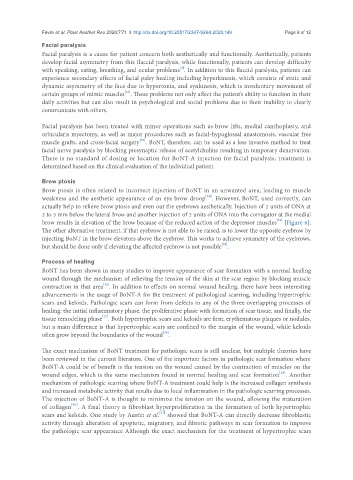Page 847 - Read Online
P. 847
Favre et al. Plast Aesthet Res 2020;7:71 I http://dx.doi.org/10.20517/2347-9264.2020.149 Page 9 of 12
Facial paralysis
Facial paralysis is a cause for patient concern both aesthetically and functionally. Aesthetically, patients
develop facial asymmetry from this flaccid paralysis, while functionally, patients can develop difficulty
[3]
with speaking, eating, breathing, and ocular problems . In addition to this flaccid paralysis, patients can
experience secondary effects of facial palsy healing including hyperkinesis, which consists of static and
dynamic asymmetry of the face due to hypertonia, and synkinesis, which is involuntary movement of
[23]
certain groups of mimic muscles . These problems not only affect the patient’s ability to function in their
daily activities but can also result in psychological and social problems due to their inability to clearly
communicate with others.
Facial paralysis has been treated with minor operations such as brow lifts, medial canthoplasty, and
orbicularis myectomy, as well as major procedures such as facial-hypoglossal anastomosis, vascular free
[23]
muscle grafts, and cross-facial surgery . BoNT, therefore, can be used as a less invasive method to treat
facial nerve paralysis by blocking presynaptic release of acetylcholine resulting in temporary denervation.
There is no standard of dosing or location for BoNT-A injection for facial paralysis; treatment is
determined based on the clinical evaluation of the individual patient.
Brow ptosis
Brow ptosis is often related to incorrect injection of BoNT in an unwanted area, leading to muscle
weakness and the aesthetic appearance of an eye brow droop . However, BoNT, used correctly, can
[24]
actually help to relieve brow ptosis and even out the eyebrows aesthetically. Injection of 2 units of ONA at
2 to 3 mm below the lateral brow and another injection of 2 units of ONA into the corrugator at the medial
[24]
brow results in elevation of the brow because of the reduced action of the depressor muscles [Figure 8].
The other alternative treatment, if that eyebrow is not able to be raised, is to lower the opposite eyebrow by
injecting BoNT in the brow elevators above the eyebrow. This works to achieve symmetry of the eyebrows,
but should be done only if elevating the affected eyebrow is not possible .
[25]
Process of healing
BoNT has been shown in many studies to improve appearance of scar formation with a normal healing
wound through the mechanism of relieving the tension of the skin at the scar region by blocking muscle
[26]
contraction in that area . In addition to effects on normal wound healing, there have been interesting
advancements in the usage of BoNT-A for the treatment of pathological scarring, including hypertrophic
scars and keloids. Pathologic scars can form from defects in any of the three overlapping processes of
healing: the initial inflammatory phase, the proliferative phase with formation of scar tissue, and finally, the
[27]
tissue remodeling phase . Both hypertrophic scars and keloids are firm, erythematous plaques or nodules,
but a main difference is that hypertrophic scars are confined to the margin of the wound, while keloids
[28]
often grow beyond the boundaries of the wound .
The exact mechanism of BoNT treatment for pathologic scars is still unclear, but multiple theories have
been reviewed in the current literature. One of the important factors in pathologic scar formation where
BoNT-A could be of benefit is the tension on the wound caused by the contraction of muscles on the
wound edges, which is the same mechanism found in normal healing and scar formation . Another
[29]
mechanism of pathologic scarring where BoNT-A treatment could help is the increased collagen synthesis
and increased metabolic activity that results due to local inflammation in the pathologic scarring processes.
The injection of BoNT-A is thought to minimize the tension on the wound, allowing the maturation
of collagen . A final theory is fibroblast hyperproliferation in the formation of both hypertrophic
[30]
[31]
scars and keloids. One study by Austin et al. showed that BoNT-A can directly decrease fibroblastic
activity through alteration of apoptotic, migratory, and fibrotic pathways in scar formation to improve
the pathologic scar appearance Although the exact mechanism for the treatment of hypertrophic scars

